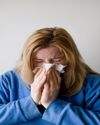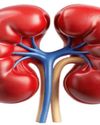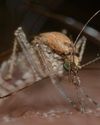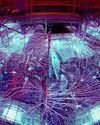Fish exposed to Microplastics pollution since 1950s
Scientific India
|November - December 2021
Plastics is an avoidable thing for modern Pcivilization, it is impossible to picture a future without it. Plastics are ubiquitous and it is included in food packaging, automobiles, clothes, fishing gear, and medical devices. Plastics are highly used because of its features such as lightness, strength, durability, and low cost, among other alternatives. Plastics benefits are overshadowed by their drawbacks, such as their strong resistance to deterioration and the real fact that they get accumulate in nature due to poor management of waste in many parts of the world. This can be particularly noticeable on beaches and in oceans, where currents and wind carry plastic trash.

Plastics and microplastics
According to Eriksen et al. 2014 there are around 5 trillion plastic bits of all sizes floating in the oceans, which weighs about 250,000 tonnes. Growing awareness of plastic pollution of ocean has led to better plastic waste management, prohibitions were imposed by several nations on the use of microplastics in cosmetics, and in the use of disposable plastic products like shopping bags, cutlery etc. Plastics which are smaller than 5 mm are classified as Microplastics. Microplastics are usually divided into two categories according to the source namely primary and secondary. Microplastics are released into the environment either accidently or through wastewater. Pellets used in the production of bigger plastic goods, as well as microbeads used in cosmetics and industrial processes are the principal sources. Plastic fragmentation, weathering of plastic debris on shorelines, sea, and UV induced brittleness of plastics are the secondary sources of microplastics.
Microplastics in Fishes and Bivalves
Rochman and his team conducted a study on the 76 whole fish which includes 11 species purchased from Indonesian fish market and they discovered that gastrointestinal track of these species contains about 28 percentage of plastic waste. The same team has evaluated the 64 whole fish which includes 12 species purchased from California and they identified that 25 percent microplastics are available in the gut of these species.
このストーリーは、Scientific India の November - December 2021 版からのものです。
Magzter GOLD を購読すると、厳選された何千ものプレミアム記事や、10,000 以上の雑誌や新聞にアクセスできます。
すでに購読者ですか? サインイン
Scientific India からのその他のストーリー
Scientific India
Japanese physicists were the first to measure the most tolerant entanglement state, the W state
There are many unusual things that happen in the world of quantum physics.
3 mins
September - October 2025

Scientific India
The Fifth Force: Could It Unlock the Secret of Dark Matter?
What if the universe is powered by a force we've never seen before? For centuries, science has explained nature with four fundamental forces.
3 mins
September - October 2025

Scientific India
A flu test you can chew
As flu season nears in the northern hemisphere, scientists are exploring a surprising new way to detect infection: through taste.
1 mins
September - October 2025

Scientific India
Lab-Grown Kidney Brings Artificial Organ Dream Closer to Reality
In a major leap toward bioengineered organ replacement, scientists have successfully grown human kidney 'assembloids' in the laboratory that mimic key structural and functional features of natural kidneys.
1 min
September - October 2025

Scientific India
Your pumpkin might be hiding a toxic secret
Pumpkins, squash, zucchini, and other members of the gourd family have a surprising trait: they can take up pollutants from the soil and store them in their edible parts.
1 mins
September - October 2025

Scientific India
2025 Nobel Prize in Physics Reveals Quantum Secrets in Superconducting Circuits
The 2025 Nobel Prize in Physics has been awarded to John Clarke, Michel H. Devoret, and John M. Martinis for their pioneering experiments that brought quantum mechanics from the invisible atomic world to the macroscopic scale a system large enough to hold in your hand.
1 mins
September - October 2025

Scientific India
Genomic Evidence Redefines the Evolutionary Age of Mosquitoes
A new genetic analysis has shaken up what we thought we knew about one of humanity's most notorious pests the mosquito.
1 min
September - October 2025

Scientific India
Nobel Prize in Chemistry 2025: Building Molecular Architectures with Room to Breathe
In a scientific breakthrough that bridges molecular design with planetary-scale problems, the 2025 Nobel Prize in Chemistry has been awarded to Susumu Kitagawa, Richard Robson, and Omar Yaghi.
1 mins
September - October 2025

Scientific India
Guardians of Immunity: Nobel Prize 2025 Honors Discoveries that Keep the Immune System in Check
The 2025 Nobel Prize in Physiology or Medicine has been awarded to Mary E. Brunkow, Fred Ramsdell, and Shimon Sakaguchi for their groundbreaking discoveries in the field of peripheral immune tolerance a crucial mechanism that prevents the body's immune system from turning against itself.
1 mins
September - October 2025

Scientific India
'Is cold nuclear fusion feasible?
In early May 1989, two chemists from the University of Utah, Pons and Fleischmann, arrived in Washington, U.S.A. The aim is to present their findings to members of the US Congress.
3 mins
September - October 2025
Translate
Change font size

